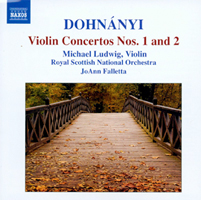Dohnányi: Violin Concertos No 1 & 2 / Michael Ludwig, Violin, Joann Falletta, Royal Scottish National Orchestra.
 |
Release Date: 04/29/2008 Label: Naxos Catalog #: 8570833 Spars Code: DDD Composer: Ernö von Dohnányi Performer: Michael Ludwig Conductor: JoAnn Falletta Orchestra/Ensemble: Royal Scottish National Orchestra Recorded in: Stereo Length: 1 Hours 11 Mins. |
The opening theme of Ernö Dohnányi's Violin Concerto No. 1 (1915) sounds strikingly like something out of a Harry Potter film, creating the same kind of minor-key-mysterious atmosphere--that is until the solo violin enters with its agitated pronouncements. Often it sounds as if the violin were not at all pleased with this introductory mood and does its best to dispel it. But then the soothing second theme steals in, and the violin is at least temporarily calmed. Dohnányi's solo writing is stunning in its originality and virtuosity, yet violinist Michael Ludwig presents it with confidence, poise, and polish. The serene Andante ushers in a beguiling tranquil mood before the lively scherzo dances about. Dohnányi's theme and variations finale blatantly borrows from the same movement in Brahms' Symphony No. 1, but happily, Dohnányi's less pretentious finale is a lot more fun, even with the return of the first movement's darker theme.
Violin Concerto No. 2 was completed more than three decades later in 1949, and right away the change in the composer's harmonic language shows in the dissonant opening violin cadenza. But far from being atonal or modernist, Dohnányi's work continues the tradition of consonant tonality, albeit a little stretched at the edges. This gives the music great expressive range, and the first movement surges with drama and emotion. As with the First concerto, this one also is in four movements, though they fit within the usual concerto duration (about 30 minutes--10 minutes shorter than No. 1). A charming intermezzo comes second, followed by a lovely and lyrical Adagio. The buoyant allegro finale brings the work to a happy conclusion. Again the violin writing is superb (wonderfully rendered by Ludwig), as is the accompaniment, fleshed out in the composer's robust and colorful orchestration, and beautifully performed by JoAnn Falletta and the Royal Scottish National Orchestra. Naxos' spacious recording has satisfying bloom, presence, and wide dynamic range. These are excellent pieces that ought to be in the modern performance repertory. If you don't know these works, you owe to yourself to hear this disc.
--Victor Carr Jr, ClassicsToday.com